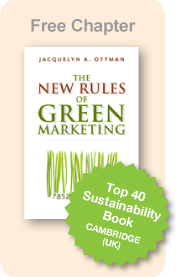Jacquie Ottman's
Green Marketing Blog
What Green Marketers Can Learn from Prius’ Success
March 30, 2008 by Jacquelyn Ottman
Hardly a week goes by without Toyota’s Prius making green marketing headlines. Let's take a step back and analyze why this product has been so wildly successful, attracting a broad swath of consumers — and not just deep-green ones — like a powerful magnet, all the while creating a new definition of automotive cool. By Jacquelyn Ottman
Let’s start with the car itself. Its distinctive styling and unique silhouette acted as a moving billboard for the new technology. Inside, passengers get all the creature comforts they expect from pricier vehicles (including BMWs from whom they stole some market share) like ample leg room and trunk space. They also found a dashboard monitor letting them know just how many MPGs they were getting moment to moment. This feature in essence tangibilized the environmental benefits while making the car that much more fun to drive.
Helping to reinforce the car’s image as cool were appearances by Leonardo DiCaprio, Gwyneth Paltrow, and other Hollywood celebrities organized by the Environmental Media Association.
Such deft design and marketing underscores why “Makes a Statement about Me” is the number one reason why Prius owners buy their cars by far (at 57%), (followed by “Other” (e.g., incentives), Higher Fuel Economy (36%), Distinctive Styling (33%), Lower Emissions (25%), and New Technology (7%) ).(Source: CNW Marketing Research, Second Quarter 2007)
These results also suggest that Toyota was ultimately successful at bringing in a mainstream audience. How did they do it?
A look over the seven years of marketing communications shows that at various times, Toyota targeted, not just the “deep green” consumers who would be wowed by the cars 55 mgh performance and lower emissions, but rather, the company deftly aimed appropriate messages at various car buyer market segments, either
simultaneously or at different times.
For instance, the $10 million multi-pronged marketing campaign kicked off with an appeal to early adopters of new technology who would appreciate the car’s quiet ride.
A supplemental campaign reinforced the car’s green bona fides and secured the green audience by talking about endorsements from such groups as the Sierra Club and National Wildlife Federation.
Later on, when gas prices spiked to $3.00 and counting, the message shifted to fuel efficiency where it remains today.
And it didn’t hurt that various federal and state laws provided financial incentives and even preference for hybrid cars in high occupancy lanes.
What does this mean for your green brand? As I've warned before, avoid the temptation to lead with environmental benefits. While this may help you pick up some market share among the deep greens or LOHAS consumers, identify the more direct, primary benefits of your products in order to draw in a more mainstream audience.
Everyone’s an environmentalist at heart, so bring in the environmental benefits secondarily, because they can supply the net extra value that can break a tie at the shelf.
While you’re at it, underscore your green credibility by using trusted eco-logos (Energy Star, USDA Organic, Transfair’s Fairtrade and FSC are among the top) or associations with big name environmental groups.
One last point — and it’s the one that put Prius over the top, invest in design.
Nike’s Considered line, Method’s “Tear Drop” dishwashing liquid bottle (pictured), and Apple’s iPhone are examples of consumers responding to good design for products they consume in public, as well as at home.
Click here to join our mailing list.



 ShareThis
ShareThis

